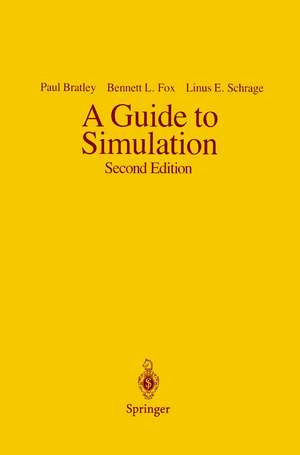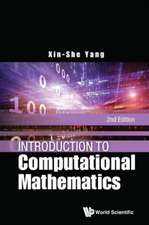A Guide to Simulation
Autor Paul Bratley, Bennet L. Fox, Linus E. Schrageen Limba Engleză Paperback – 17 oct 2012
| Toate formatele și edițiile | Preț | Express |
|---|---|---|
| Paperback (1) | 950.52 lei 6-8 săpt. | |
| Springer – 17 oct 2012 | 950.52 lei 6-8 săpt. | |
| Hardback (1) | 955.25 lei 6-8 săpt. | |
| Springer – 13 mai 1987 | 955.25 lei 6-8 săpt. |
Preț: 950.52 lei
Preț vechi: 1159.17 lei
-18% Nou
Puncte Express: 1426
Preț estimativ în valută:
181.90€ • 197.52$ • 152.80£
181.90€ • 197.52$ • 152.80£
Carte tipărită la comandă
Livrare economică 23 aprilie-07 mai
Preluare comenzi: 021 569.72.76
Specificații
ISBN-13: 9781461264576
ISBN-10: 146126457X
Pagini: 424
Ilustrații: XXI, 397 p.
Dimensiuni: 155 x 235 x 22 mm
Greutate: 0.59 kg
Ediția:Softcover reprint of the original 2nd ed. 1987
Editura: Springer
Colecția Springer
Locul publicării:New York, NY, United States
ISBN-10: 146126457X
Pagini: 424
Ilustrații: XXI, 397 p.
Dimensiuni: 155 x 235 x 22 mm
Greutate: 0.59 kg
Ediția:Softcover reprint of the original 2nd ed. 1987
Editura: Springer
Colecția Springer
Locul publicării:New York, NY, United States
Public țintă
ResearchCuprins
1 Introduction.- 1.1. Systems, Models, and Simulation.- 1.2. Verification, Approximation, and Validation.- 1.3. States, Events, and Clocks.- 1.4. Simulation—Types and Examples.- 1.5. Introduction to Random Numbers.- 1.6. Perspective on Experimental Design and Estimation.- 1.7. Clock Mechanisms.- 1.8. Hints for Simulation Programming.- 1.9. Miscellaneous Problems.- 2 Variance Reduction.- 2.1. Common Random Numbers.- 2.2. Antithetic Variates.- 2.3. Control Variates.- 2.4. Stratification.- 2.5. Importance Sampling.- 2.6. Conditional Monte Carlo.- 2.7. Jackknifing.- 3 Output Analysis.- 3.1. Introduction.- 3.2. Analysis of Finite-Horizon Performance.- 3.3. Analysis of Steady-State Performance.- 3.4. Analysis of Transaction-Based Performance.- 3.5. Indirect Estimation via r = ?s.- 3.6. Problems.- 3.7. Renewal Theory Primer.- 3.8. Standardized Time Series.- 4 Rational Choice of Input Distributions.- 4.1. Addition and the Normal Distribution.- 4.2. Multiplication and the Lognormal.- 4.3. Memorylessness and the Exponential.- 4.4. Superposition, the Poisson, and the Exponential.- 4.5. Minimization and the Weibull Distribution.- 4.6. A Mixed Empirical and Exponential Distribution.- 4.7. Extreme Values and Spacings.- 4.8. When Not to Use a Theoretical Distribution.- 4.9. Nonstationary Poisson Processes.- 5 Nonuniform Random Numbers.- 5.1. Introduction.- 5.2. General Methods.- 5.3. Continuous Distributions.- 5.4. Discrete Distributions.- 5.5. Problems.- 5.6. Timings.- 6 Uniform Random Numbers.- 6.1. Random Introductory Remarks.- 6.2. What Constitutes Randomness.- 6.3. Classes of Generators.- 6.4. Choosing a Good Generator Based on Theoretical Considerations.- 6.5. Implementation of Uniform Random Number Generators.- 6.6. Empirical Testing of Uniform Random Number Generators.-6.7. Proper Use of a Uniform Random Number Generator.- 6.8. Exploiting Special Features of Uniform Generators.- 7 Simulation Programming.- 7.1. Simulation With General-Purpose Languages.- 7.2. Simscript.- 7.3. GPSS.- 7.4. Simula.- 7.5. General Considerations in Simulation Programming.- 8 Programming to Reduce the Variance.- 8.1. Choosing an Input Distribution.- 8.2. Common Random Numbers.- 8.3. Antithetic Variates.- 8.4. Control Variates.- 8.5. Stratified Sampling.- 8.6. Importance Sampling.- 8.7. Conditional Monte Carlo.- 8.8. Summary.- Appendix A The Shapiro—Wilk Test for Normality.- Appendix L Routines for Random Number Generation.- Appendix X Examples of Simulation Programming.- References.- Author Index.














